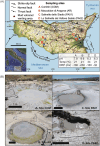Variations in microbial community compositions and processes imposed under contrast geochemical contexts in Sicilian mud volcanoes, Italy
- PMID: 39372275
- PMCID: PMC11449744
- DOI: 10.3389/fmicb.2024.1461252
Variations in microbial community compositions and processes imposed under contrast geochemical contexts in Sicilian mud volcanoes, Italy
Abstract
Terrestrial mud volcanoes represent surface features of channels for subsurface methane transport and, therefore, constitute an important source of methane emission from natural environments. How microbial processes regulate methane emissions in terrestrial mud volcanoes has yet to be fully addressed. This study demonstrated the geochemical characteristics and microbial communities of four mud volcano and seep sites in two geological settings of Sicily, Italy. At sites within the accretionary wedge that exhibited higher methane and sulfate concentrations, the communities were dominated by members capable of catalyzing methane and sulfate metabolisms and organic degradation. In particular, both anaerobic and aerobic methanotrophs were abundant and their abundance distribution coincided with the geochemical transition. In contrast, the sites near Mount Etna were characterized by high fluid salinity, CO2, and low methane and sulfate concentrations, with communities consisting of halophilic organic degraders and sulfur metabolizers, along with a minor presence of aerobic methanotrophs. Substantial variations in community composition and geochemistry across spatial and vertical redox gradients suggest that physicochemical contexts imposed by the geology, fluid path, and source characteristics play a vital role in shaping community composition and cycling of methane, sulfur and organic carbon in Sicily mud volcanoes.
Keywords: AOM; Sicily; halophile; methane; microbial community; mud volcano.
Copyright © 2024 Chen, Chiu, Tu, Italiano, Wang and Lin.
Conflict of interest statement
The authors declare that the research was conducted in the absence of any commercial or financial relationships that could be construed as a potential conflict of interest.
Figures





Similar articles
-
Microbial Community Composition and Functional Capacity in a Terrestrial Ferruginous, Sulfate-Depleted Mud Volcano.Front Microbiol. 2017 Nov 2;8:2137. doi: 10.3389/fmicb.2017.02137. eCollection 2017. Front Microbiol. 2017. PMID: 29163423 Free PMC article.
-
Spatial variations of community structures and methane cycling across a transect of Lei-Gong-Hou mud volcanoes in eastern Taiwan.Front Microbiol. 2014 Mar 25;5:121. doi: 10.3389/fmicb.2014.00121. eCollection 2014. Front Microbiol. 2014. PMID: 24723919 Free PMC article.
-
Sulfur and Methane-Oxidizing Microbial Community in a Terrestrial Mud Volcano Revealed by Metagenomics.Microorganisms. 2020 Aug 31;8(9):1333. doi: 10.3390/microorganisms8091333. Microorganisms. 2020. PMID: 32878336 Free PMC article.
-
Anthropogenic and Environmental Constraints on the Microbial Methane Cycle in Coastal Sediments.Front Microbiol. 2021 Feb 18;12:631621. doi: 10.3389/fmicb.2021.631621. eCollection 2021. Front Microbiol. 2021. PMID: 33679659 Free PMC article. Review.
-
Thermophilic methanotrophs: in hot pursuit.FEMS Microbiol Ecol. 2019 Sep 1;95(9):fiz125. doi: 10.1093/femsec/fiz125. FEMS Microbiol Ecol. 2019. PMID: 31374570 Review.
References
-
- Acinas S. G., Sarma-Rupavtarm R., Klepac-Ceraj V., Polz M. F. (2005). PCR-induced sequence artifacts and bias: insights from comparison of two 16s rRNA clone libraries constructed from the same sample. Appl. Environ. Microbiol. 71, 8966–8969. doi: 10.1128/AEM.71.12.8966-8969.2005, PMID: - DOI - PMC - PubMed
-
- Allard P., Jean-Baptiste P., D’Alessandro W., Parello F., Parisi B., Flehoc C. (1997). Mantle-derived helium and carbon in groundwaters and gases of Mount Etna, Italy. Earth Planet. Sci. Lett. 148, 501–516. doi: 10.1016/s0012-821x(97)00052-6 - DOI
-
- Amann R. I., Binder B. J., Olson R. J., Chisholm S. W., Devereux R., Stahl D. A. (1990). Combination of 16S rRNA-targeted oligonucleotide probes with flow cytometry for analyzing mixed microbial populations. Appl. Environ. Microbiol. 56, 1919–1925. doi: 10.1128/aem.56.6.1919-1925.1990, PMID: - DOI - PMC - PubMed
LinkOut - more resources
Full Text Sources

